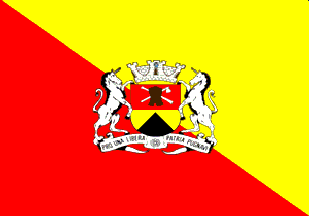 image by Blas Delgado Ortiz
image by Blas Delgado Ortiz
Last modified: 2008-08-02 by ian macdonald
Keywords: sao paulo | sorocaba |
Links: FOTW homepage |
search |
disclaimer and copyright |
write us |
mirrors
Other sites:
"The upper field, formed by the diagonal, in golden yellow, signifies the wealth, strength, and unbreakable faith of the people of Sorocaba at all times, as well as the purity and constancy we possess in our constructive work in all sectors of human activity. The lower field, in red, symbolizes the valor and intrepidity of the many Sorocaban bandeiras [colonial exploring expeditions] that left from here, with valorous souls and determined spirits, in quest of glory, enlarging the horizons of the fatherland, planting cities, and sowing the seeds of progress."
"The coat of arms of the city on the center symbolizes all the historical aspects and deeds of Sorocaba that are invoked in it." [The coat of arms is further described below.] (Law No. 358 of 22 February 1954)
Measurements of the flag:
The following information on the coat of arms is from
www.sorocaba.com.br/historia/brasao: "In the upper part of the two-part shield, the panoply composed
of the suit of armor, the arcquebus, and the axe, drawn in natural colors on a red field, represent the great Sorocaban bandeirantes
Paschoal Moreira Cabral, Fernão Dias Falcão, the Paes de Barros brothers, and others.
The lower part records the early iron mining, the first carried out in Brazil, in the environs of Sorocaba on Mount Araçoiaba -
a black mountain on which ore was found. The supporters of the shield, two unicorns, which are heraldic horses, recall the
horse fairs that had a notable role in maintaining national unity in southern Brazil. The small shield with a fleur-de-lis above the main
gate of the mural crown reminds us that the city had as its patron Our Lady of the Bridge. The motto, Pro Una Libera Patria Pugnavi,
or "I have fought for a united and free fatherland," records the roll of Sorocaba in the horse fairs as well as the part it took
in the events of independence, such as the creation of the Sorocaban Battalion, and other facts relative to the
efforts of Sorocaba toward the implantation of liberty in Brazil. The cogwheel printed on the scroll recalls the notable preeminence
achieved in our own days by Sorocaban industry." The designer of the coat of arms was Dr. Affonso d'Escragnolle Taunay. (Law No. 189,
of 23 March 1925 and Law No. 47 of 13 September 1948)
Reported by Dov Gutterman, 24 February 2002
Translated by Joseph McMillan,